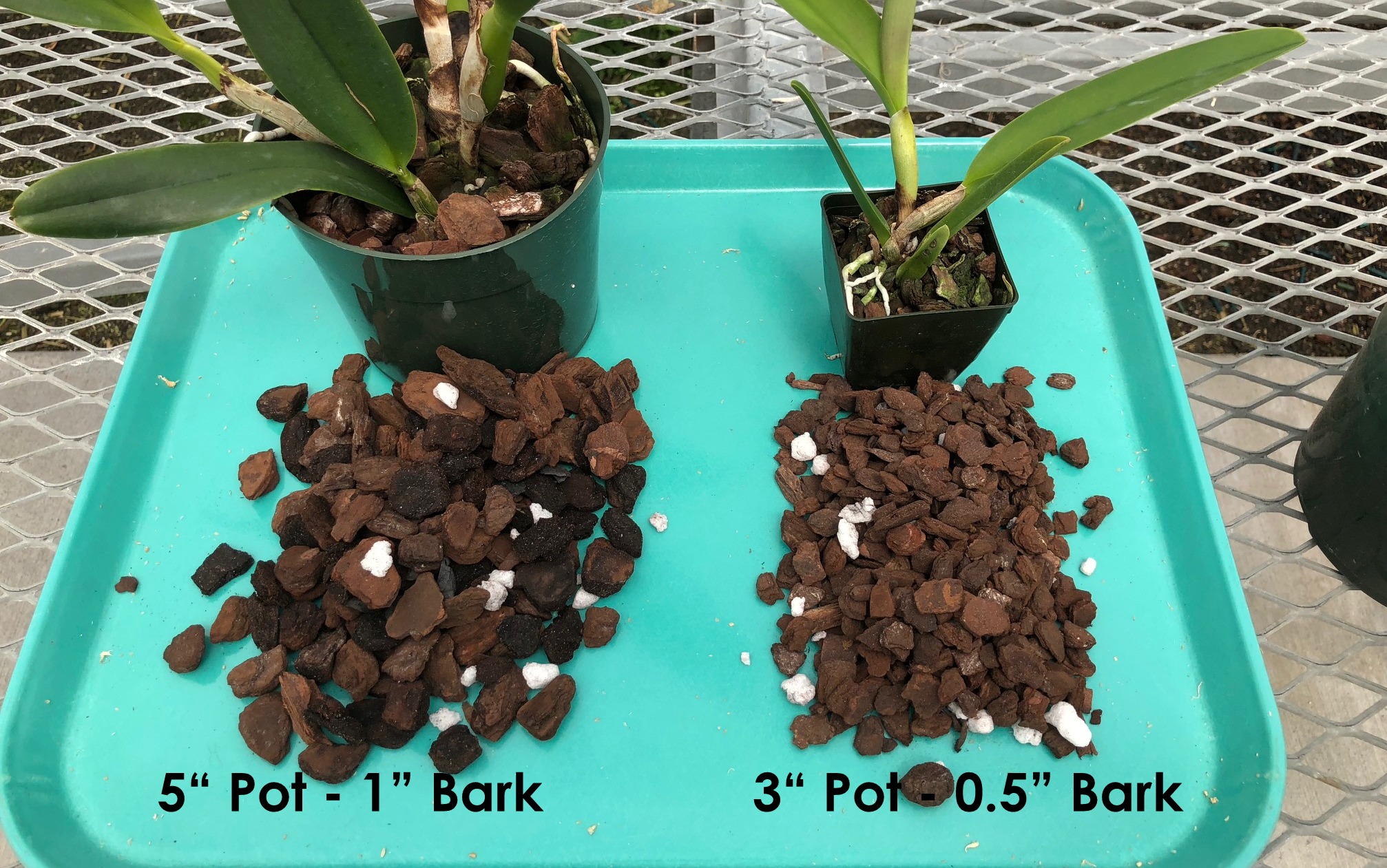When it comes to potting orchids, one of the most common questions is “How much soil do orchids need?” The answer, unfortunately, is not a simple one. There are many factors to consider when deciding how much soil to use for your orchid, such as the type of orchid, the size of the pot, and whether you are using a potting mix or creating your own mix.
Orchids are a diverse and exotic group of flowers, and they come in all shapes, sizes, and colors. Though they’re often associated with tropical locales, you can actually find them growing all over the world. Orchids are also relatively easy to care for, and they make beautiful houseplants.
One of the most common questions about orchids is how much soil they need. The answer depends on the type of orchid you have. Some orchids (like phalaenopsis) do best in a potting mix that’s light and airy, while others (like cymbidiums) prefer a heavier mix that retains more moisture.
In general, most orchids need a potting mix that drains well but still holds some moisture. A good rule of thumb is to water your orchid when the potting mix is dry to the touch. If you’re not sure what type of potting mix your orchid needs, ask your florist or nursery for advice.
How to Grow Orchids Without Soil
Orchids are one of the most beautiful and popular flowers in the world. They come in a wide variety of colors, shapes, and sizes. But did you know that you can grow orchids without soil?
That’s right! Orchids can be grown in just about any type of container as long as they have proper drainage. Here are some tips on how to grow orchids without soil:
1. Choose the right container. Orchids need a container that has good drainage. Clay pots are a great option because they allow water to evaporate quickly.
You can also use plastic pots with holes drilled in the bottom for drainage. Be sure to choose a pot that is only slightly larger than the root ball of your orchid so that it doesn’t get too much water.
2. Add an Orchid Bark Mix.
To provide nutrients and help with drainage, add an orchid bark mix to your potting media. This can be found at most garden centers or online retailers specializing in orchid supplies. Simply fill your pot about halfway with the bark mix and then top it off with charcoal (another great option for drainage).
3 . Water properly . One of the most important things to remember when growing orchids without soil is to water properly .
Over-watering is one of the biggest mistakes made when growing these beautiful flowers . Be sure to wait until the potting media has dried out completely before watering again . And when you do water , be sure to use lukewarm water and soak the roots thoroughly .
Orchid Mix Soil
If you’re an orchid enthusiast, you know that finding the perfect mix of soil for your plants can be a challenge. There are a variety of commercial mixes available, but they can be expensive and may not be ideal for your particular type of orchid. Luckily, it’s easy to make your own mix at home with a few simple ingredients.
The most important ingredient in any Orchid Mix Soil is perlite. Perlite is a lightweight volcanic rock that has been heated to expand its pores. This makes it an excellent aerator for the soil, allowing roots to breath and preventing waterlogging.
It also helps to keep the mix from compacting over time.
In addition to perlite, you’ll need some bark chips or shredded bark. Bark provides essential nutrients for Orchids as well as helping to regulate moisture levels in the soil mix.
Be sure to choose bark that is free of chemical treatments and pesticides. Cypress and cedar are two good choices forOrchid Mix Soil .
Finally, you’ll need some sphagnum moss to help retain moisture and keep roots cool in summer heat.
Sphagnum moss is also helpful in preventing compaction of the soil mix over time.
To make your own Orchid Mix Soil , simply combine equal parts perlite, bark chips or shredded bark, and sphagnum moss. If you want to add extra drainage, you can add more perlite than the other ingredients.
What is the Best Potting Mix for Orchids
Orchids are a beautiful and popular choice for indoor plants, but they can be finicky when it comes to potting mix. So, what is the best potting mix for orchids?
There are a few things to look for in a good potting mix for orchids.
The mix should be well-draining, yet hold moisture well. It should also be lightweight and airy, so that the roots can breathe. And finally, it should have some nutrients to support growth.
One option is an African violet potting mix, which has all of these qualities. You can also make your own potting mix by mixing together peat moss, perlite, and coarse sand in equal parts. Another option is to use bark chips instead of sand.
Whatever you choose, make sure that the ingredients are finely ground so that they don’t compact too tightly around the roots.
When repotting your orchid, water it well before adding fresh potting mix. This will help prevent shock to the plant.
Gently loosen the roots and place them in the new potting mixture, being careful not to damage them. Water again after repotting and keep the plant in a warm spot with indirect light until new growth appears.
Can I Use Regular Potting Soil for Orchids
If you want to grow healthy and vibrant orchids, you need to use the right type of potting soil. While regular potting soil may seem like a good option, it’s actually not ideal for these delicate plants. Orchids need a light and airy potting mix that drains quickly and doesn’t retain too much moisture.
Regular potting soil is often too dense and heavy for orchids, which can lead to problems with drainage and overwatering. To get the best results, look for a specialized orchid potting mix at your local garden center or nursery.
How Do You Repot an Orchid for Beginners
When it comes to repotting an orchid, there are a few things that you need to keep in mind. First of all, you need to make sure that you have the right pot for your plant. The pot should be slightly larger than the one that your plant is currently in so that it has room to grow.
Secondly, you need to use a well-draining potting mix. This will help to ensure that your plant doesn’t get too much water and drown. Thirdly, when repotting an orchid, be sure to handle the roots very carefully.
They are delicate and can easily be damaged. Finally, once your plant is in its new pot, be sure to give it plenty of light and water it regularly. With a little bit of care, your orchid will thrive in its new home!

Credit: akatsukaorchid.com
Do Orchids Like Big Or Small Pots?
If you’re wondering whether orchids like big or small pots, the answer is that it depends on the type of orchid. Some orchids, such as Phalaenopsis (moth orchids), prefer to be pot-bound and do not thrive if they are repotted into a larger pot. On the other hand, other types of orchids, such as Cattleya (corsage orchids), will benefit from being repotted into a larger pot every few years.
When it comes to pot size, a good rule of thumb is to choose a pot that is only 1-2 inches wider than the root ball of your orchid. If you’re not sure what size pot to choose, err on the side of choosing a smaller pot rather than a larger one. This is because it’s easier to overwater an orchid in a large pot than in a small one.
Do Orchids Need Deep Pots?
Orchids are a diverse group of plants, and their potting needs vary depending on the species. Some orchids, such as Phalaenopsis (moth orchids), prefer shallower pots while others, like Epidendrum (butterfly orchids), need deeper pots. In general, most orchids do best in pots that are only slightly larger than their root ball.
This allows the roots to stay moist but not soggy, and also provides good drainage. If you’re not sure what size pot your orchid needs, ask your local nursery or search for information specific to your species online.
How Deep Should an Orchid Planter Be?
If you’re growing orchids in pots, the pot should be only slightly larger than the root ball of the plant. This is because orchids are epiphytes, meaning they grow in trees or on other plants in nature, and their roots are accustomed to having good air circulation around them. If the pot is too large, the roots will stay too wet and may rot; if it’s too small, the plant won’t have enough room to grow.
As for how deep the pot should be, that depends on the size of the plant. A general rule of thumb is that the pot should be about one-third as deep as it is wide. So, for example, if your orchid pot is 8 inches wide, it should be about 2.5 inches deep.
Do Orchids Need Soil Or Bark?
If you’re new to growing orchids, you might be wondering what type of potting mix is best for your plant. While there are many different mixes available on the market, it’s important to understand that not all orchids need soil or bark. In fact, many epiphytic varieties do just fine when grown in an airy potting medium that allows their roots plenty of room to breath.
That being said, if you’re looking to grow a terrestrial orchid variety, then you will need to provide it with a rich potting mix that drains well and contains some organic matter. A good blend for terrestrial orchids includes two parts sphagnum peat moss and one part perlite or coarse sand. You can also add in some slow-release fertilizer pellets to help give your plant a nutrient boost.
What is the best Potting Mix for your Orchid? – Learn about Orchid Media! Orchid Care for Beginners
Do Orchids Require a Lot of Water If They Have Less Soil?
Orchids are unique plants with specific water requirements for optimal growth. Interestingly, their water needs are not solely dependent on the amount of soil present. While orchids need adequate moisture, they have a natural ability to retain water in their tissues and roots. Thus, even with less soil, orchids can adapt to their environment and thrive with proper watering techniques. Understanding the water requirements for orchids is crucial for maintaining their health and promoting beautiful blooms.
Conclusion
Orchids are a type of plant that is known for being delicate and needing special care. One important factor in taking care of orchids is the amount of soil they need. Too much or too little soil can be detrimental to the plant.
The general rule of thumb is that orchids need about an inch of potting mix. This mix should be well-draining and contain ingredients such as bark, perlite, and charcoal. It’s also important to make sure that the pot has drainage holes so that the roots don’t get waterlogged.
If you’re not sure if your orchid has enough soil, you can check by gently pressing on the potting mix around the plant. If it feels compacted, then it’s likely that your orchid needs more soil. On the other hand, if there is a lot of loose material around the plant, then it’s possible that there is too much soil.
In general, it’s best to err on the side of caution and give your orchid a little bit more soil than it needs rather than too little. With proper care, your orchid will thrive and bloom for many years to come!






